6. Bodmin Moor
Bodmin Moor is a compact stretch of wild landscape—only about ten miles across—cut through by four rivers. It’s the smallest and most accessible of the West Country’s major moors, with its highest point reaching 1,375 feet (419 meters) from a base of around 1,000 feet (305 meters).
Despite its size, it feels vast and remote. The empty landscape, scattered with Bronze Age ruins, gives it a quiet, lonely atmosphere. That sense of isolation has inspired all kinds of myths and stories, including King Arthur legends and the writing of Daphne du Maurier.
Dozmary Pool, near the center of the moor, is tied to Arthurian lore—it’s said to be the lake where Sir Bedivere threw Excalibur. The lake has a still, mysterious feel, though it sometimes dries up in summer, casting doubt on the old belief that it’s bottomless.
One way to reach Dozmary Pool is from Jamaica Inn, near Bolventor just off the A30. It was once described by du Maurier as “alone in glory, four square to the winds,” but these days it’s a popular stop for tour buses and has lost some of that isolated charm.






















